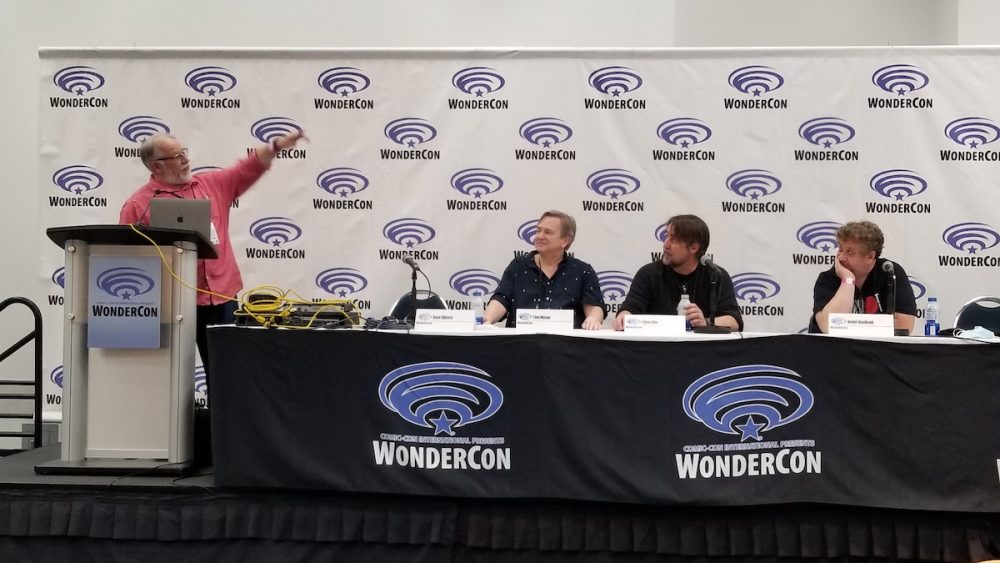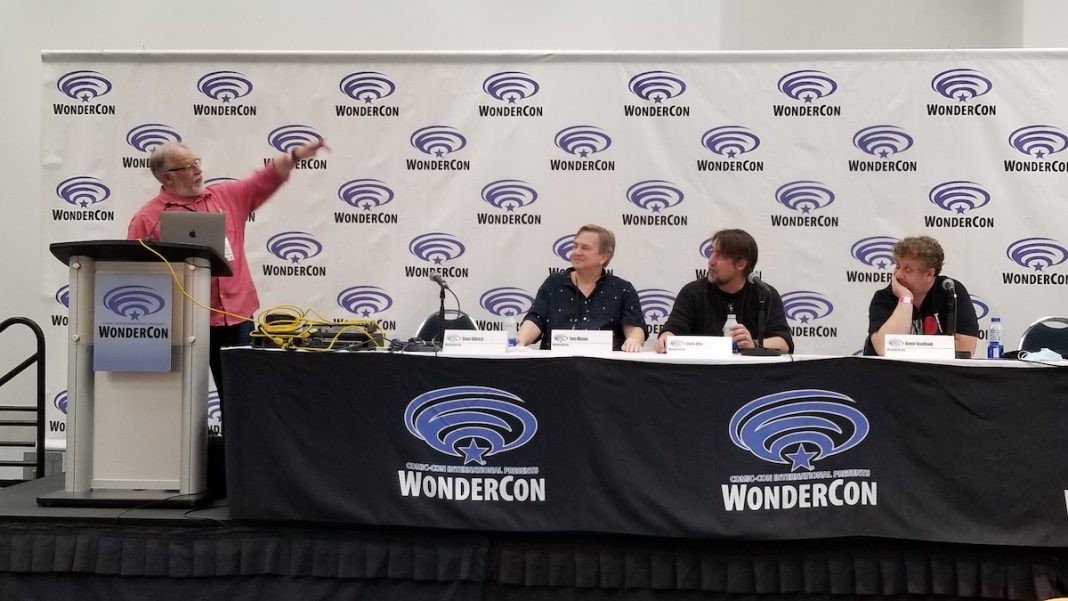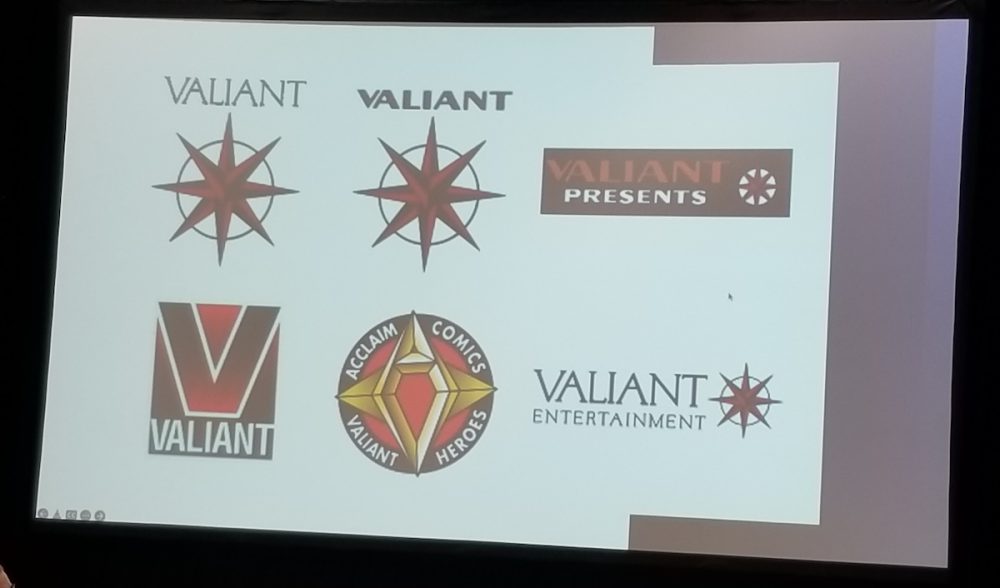By Gabriel Neeb
I always wondered if anyone has bothered to write down the history of comics as they’re happening. I lived through the great comics bust of the early 1990s which nearly destroyed Marvel Comics and did destroy a number of other publishers. There are articles here and there, some people remember it, but the whole story of the events around those years feel incomplete. An attempt to fill in one of those gaps was the “Ultraverse vs Valiant: Building Battling Worlds” panel held in Room 208 of the Anaheim Convention Center at Wondercon 2022.
Moderated by David Olbrich of YouTube’s Geekview Tavern, panelists Tom Mason (Ultraverse art director), Chris Ulm (Ultraverse Editor-in-Chief), and Kevin VanHook (Valiant writer) spent a breezy 45 minutes reminiscing about the creation of the Ultraverse and Valiant imprints.

Of course, Valiant was outnumbered, 3 to 1.
To start the panel David introduced each company with a brief history lesson about their respective foundings. Valiant having been created in 1990, their first comic being Super Mario Brothers, by parent company Voyager Communications. Ultraverse began as an offshoot of Malibu Comics in 1992 with the titles Prime, Hardcase and The Strangers.
Kevin VanHook took a few moments to discuss the philosophy of Valiant, as stipulated by the first Editor, Jim Shooter. Through Valiant’s first books (Magnus, Solar, and Rai), Shooter wanted a “real world feel” and insisted on specific time-stamps within the issues. This continued into the Valiant relaunch of 2012 where one dedicated fan of Valiant was able to advise on those books (Kevin referred to this fan as “the librarian). Kevin briefly recounted his “meteoric” rise from Valiant production manager to executive editor in that it took around nine months… after having been in comics for nine years.
When the conversation veered to Ultraverse, Tom Mason described his position as “the cranky one.” His role was to find writers for his nascent universe. And he was successful in that regard- among the writers recruited were Len Strazewski (Justice Society of America), Mike Barr (Star Trek) and, eventually, Steve Gerber (Howard the Duck).
Chris Ulm described himself as the one who put up the “chicken wire” of the universe- the guiding principles of the Ultraverse. Mainly the emphasis on character development which was a radical break from the art-driven comics industry of the ’90s era.
From this point, the moderator opened the panel to questions.
The first question was about the status of the Ultraverse characters. This was easy to answer: Disney owns them and they have choosen to not use them. A few are reputed to have made brief appearances (Rune, Topaz)- but the panel chalked that up to errors on someone’s part. An interesting wrinkle in this is that the contracts the creators of Ultraverse signed entitle them to proceeds from use of their creations in other media. As of this writing, Marvel (Disney) has chosen not to use the Ultraverse characters.
The fortunes of other characters (Dinosaurs for Hire and The Protectors) owned by Malibu also arose and why they weren’t integrated into the Ultraverse was also discussed. Chris Ulm said there were two reasons, a creative one (their mythology was already established) and a business one (the properties had run their course by 1992).
Then, in perhaps the liveliest portion of the panel, a member of the audience asked for stories of the late Steve Gerber.
Tom said he is still owed a script from Gerber! The reasoning being that, while Gerber worked for Ultraverse, he would often be advanced money… and at some point the advances were added up that Gerber should have written another script based on all the money advanced! Gerber had an erratic work schedule but he was a great talent and had significant editorial skill as well.
Years ago, before he died, Gerber revealed he suffered from undiagnosed sleep apnea which meant he could never get a full night of sleep and could then never stay awake through the day. This probably helped him creatively as it was in this period that he wrote the Howard the Duck and Defenders stories, which were praised by the whole panel. This was a segue into the story of Ultraverse character Sludge. When Chris suggested Gerber go back to his old monster characters (like Man-Thing) for inspiration, Gerber rejected the idea… until the next day when Steve called back with the idea for Sludge.
The panel continued with questions about “pitch bibles” and how to use them in comics and other entertainment ventures. Kevin said that at Valiant, bibles weren’t used in comics. The later Valiant character Ninjak, for example, was created because artist Bob Layton came up with a word after a vacation. No story yet, just a name. And thus, a character was born. As a rule of thumb, Kevin tries to keep his “pitch bibles” to 8 to 10 pages. If a story got picked up, then the bible would be expanded and made more in depth.
The panel concluded with discussion on how Sony, who released the Bloodshot movie, also had the movie rights for Valiant series Harbinger. Kevin admitted that he might have benefited more from the Bloodshot movie had it not been released days away from the first COVID lockdown. However, as Paramount now has the Harbinger rights, the dream of a series based on the Valiant universe will remain just that, for now.
Miss any of our previous WonderCon 2022 coverage? Click here!










That’s awesome. It was incredibly 90s in the best and worst ways, but I have a special fondness for Ultraverse’s Prime.
There is a Youtube channel called Uncle Jerk’s comics. The podcast goes in great detail about the origin and history of Valiant comics.
I love reading my name in print and being quoted correctly. Well done!
Comments are closed.